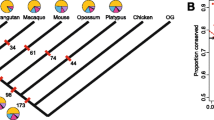Abstract
For evolution by gene duplication, differentiation of both regulatory elements and proteins is important. Particularly the former is thought to have large effects on morphological evolution, since differential expression of genes is essential for development. In this report, recent knowledge on regulatory elements is reviewed that is relevant to the population genetics aspects of gene duplication. Regulatory elements usually consist of multiple binding sites of two or more transcription factors. The amount of gene product is quantitatively regulated, and is thought to be subject to stabilizing selection. The intensity of stabilizing selection depends upon the level of constraint imposed by regulatory networks. Gene duplication has significant effects on stabilizing selection via perturbation of gene expression. It is pointed out that constraints coming from regulatory networks are most important for survival of duplicate genes, and that both drift and selection are at work in the process of acquisition of new gene expression and function.
Similar content being viewed by others
References
Amores, A., A. Force, T.-L. Yan, L. Joly, C. Amemiya, A. Fritz, R.K. Ho, J. Langeland, V. Prince, Y.-L. Wang, M. Westerfield, M. Ekker & J.H. Postlethwait, 1998. Zebrafish hox clusters and vertebrate genome evolution. Science 282: 1711-1714.
Aparicio, S., K. Hawker, A. Cottage, Y. Mikawa, L. Zuo, B. Venkatesh, E. Chen, R. Kumlauf & S. Brenner, 1997. Organization of the Fugu rubripes Hox clusters: evidence for continuing evolution of vertebrate Hox complexes. Nat. Gene. 16: 79-83.
Carroll, S.B., J.K. Grenier & S.D. Weatherbee, 2001. From DNA to Diversity. Blackwell Science, Malden, MA.
Clark, A., 1994. Invasion and maintenance of a gene duplication. Proc. Natl. Acad. Sci. USA, 91: 2950-2954.
Courseaux, A. & J.-L. Nahon, 2001. Birth of two chimera genes in the hominidae lineage. Science 291: 1293-1297.
Creighton, T.E. & N.J. Darby, 1989. Functional evolutionary divergence of proteolytic enzymes and their inhibitors. Trends Bioch. Sci. 14: 319-324.
Davidson, E.H., 2001. Genomic Regulatory Systems. Academic Press, San Diego, CA.
Gerhart, J. & M. Kirschner, 1997. Cells, Embryos, and Evolution. Blackwell Science, Malden, MA.
Hedrick, P.W., 2000. Genetics of Populations. Jones and Bartlett, Sudbury, MA 2nd edn.
Hood, L., J.H. Campbell & S.C.R. Elgin, 1975. The organization, expression and evolution of antibodies and other multigene families. Annu. Rev. Genet. 9: 305-353.
Hughes, A., 1999. Adaptive Evolution of Genes and Genomes. Oxford University Press, Oxford, UK.
Ingram, V.M., 1963. The Hemoglobins in Genetics and Evolution. Columbia University Press, Columbia, USA.
International Human Genome Sequencing Consortium, 2001. Initial sequencing and analysis of the human genome. Nature 409: 860-921.
Jacob, F., 1977. Evolution and tinkering. Science 196: 1161-1166.
Jeong, H., S.P. Mason, A.-L. Barabasi & Z.N. Oltvai, 2001. Lethality and centrality in protein networks. Nature 411: 41-42.
Kimura, M. & T. Ohta, 1969. The average number of generations until fixation of a mutant gene in a finite population. Genetics 61: 763-771.
Li, W.-H., 1997. Molecular Evolution. Sinauer Associates, Sunderland, USA.
Long, M., W. Wang & J. Zhang, 1999. Origin of new genes and source for N-terminal domain of the chimerical gene, jingwei, in Drosophila. Gene 238: 135-141.
Ludwig, M.Z., C. Bergman, N.H. Patel & M. Kreitman, 2000. Evidence for stabilizing selection in a eukaryotic enhancer element. Nature 403: 564-567.
Lynch, M. & J.S. Conery, 2000. The evolutionary fate and consequences of duplicate genes. Science 290: 1151-1155.
Lynch, M. & A. Force, 2000. The probability of duplicate gene preservation by subfunctionalization. Genetics 154: 459-473.
Mackay, T.F.C., 1995. The genetic basis of quantitative variation: numbers of sensory bristles of Drosophila melanogaster as a model system. Trends Genet. 11: 464-470.
Mackay, T.F.C. & C.H. Langley, 1990. Molecular and phenotypic variation in the achaete-scute region of Drosophila melanogaster. Nature 348: 64-66.
Ohta, T., 1972. Population size and rate of evolution. J. Mol. Evol. 1: 305-314.
Ohta, T., 1980. Evolution and variation of multigene families. Lecture Notes in Biomathematics, Springer, Berlin, vol. 37.
Ohta, T., 1987. Simulating evolution by gene duplication. Genetics 115: 207-213.
Ohta, T., 1988. Further simulation studies on evolution by gene duplication. Evolution 42: 375-386.
Ohta, T., 1994. On hypervariability at the reactive centre of proteolytic enzymes and their inhibitors. J. Mol. Evol. 39: 614-619.
Ohta, T. & H. Tachida, 1990. Theoretical study of near neutrality. I. Heterozygosity and rate of mutant substitution. Genetics 126: 219-229.
Piatigorsky, J., 1984. Lens crystallins and their gene families. Cell 38: 620-621.
Rosa, R.d., R.R. Grenier, T. Andreeva, C.E. Cook, A. Adoutte, M. Akam, S.B. Carroll & G. Balavoine, 1999. Hox genes in brachiopods and priapulids and protostome evolution. Nature 399: 772-776.
Rouquier, S., S. Taviaux, B.J. Trask, V. Brand-Arpon, G.v.d. Engh, J. Demaille & D. Giorgi, 1998. Distribution of olfactory receptor genes in the human genome. Nat. Genet. 18: 243-250.
Shubin, N., C. Tabin & S.B. Carroll, 1997. Fossils, genes and the evolution of animal limbs. Nature 388: 639-648.
Smith, N.G.C., R. Knight & L.D. Hurst, 1999. Vertebrate genome evolution: a slow shuffle or a big bang? BioEssays 21: 697-703.
Ventor, J.C. et al., 2001. The human genome. Science 291: 1304-1351.
Wagner, A., 1999. Redundant gene functions and natural selection. J. Evol. Biol. 12: 1-16.
Walsh, J.B., 1995. How often do duplicated genes evolve new functions? Genetics 139: 421-428.
White, R.J., 2001. Gene Transcription. Blackwell Science, Malden, MA.
Williams, J.A., S.W. Paddock, K. Vorwerk & S.B. Carroll, 1994. Organization of wing formation and induction of a wing-patterning gene at the dorsal/ventral compartment boundary. Nature 368: 299-305.
Zuckerkandl, E., 1994. Molecular pathways to parallel evolution. I. Gene Nexuses and their morphological correlates. J. Mol. Evol. 39: 661-678.
Zuckerkandl, E., 2001. Intrinsically driven changes in gene interaction complexity. I. The spontaneous growth of regulatory complexes. J. Mol. Evol. 53: 539-554.
Author information
Authors and Affiliations
Rights and permissions
About this article
Cite this article
Ohta, T. Evolution by Gene Duplication Revisited: Differentiation of Regulatory Elements Versus Proteins. Genetica 118, 209–216 (2003). https://doi.org/10.1023/A:1024130431575
Issue Date:
DOI: https://doi.org/10.1023/A:1024130431575




